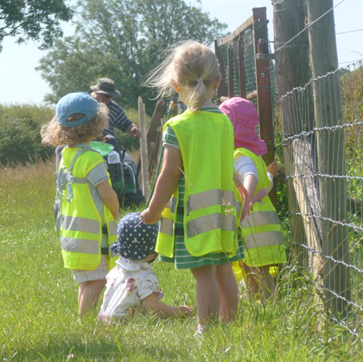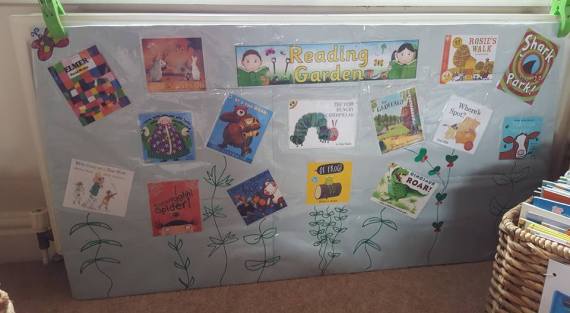Last updated 27/02/2023
The idea that there could be a such a thing as ‘good practice’ for taking children on outdoor outings began the day I witnessed an example of what I felt to be particularly bad practice. I was meeting a childminder friend at the park on a damp Spring day. She had her normal mix of three children including the two youngest (aged 18 months and two years) wrapped up in coats and strapped into her double buggy.
I took one look at her, pointed at the children’s feet, and laughed.
‘Oh no! You’ve rushed out and forgotten something. You’ve come out without their shoes!’ I said.
‘I left their shoes at home on purpose,’ she replied. ‘They won’t need them anyway. I really have no intention of taking them out of the buggy. They’ll be fine just watching the world go by.’
It was an awful situation and upset me greatly. This childminder had just had her first Ofsted inspection and had been awarded ‘good’. She seemed to feel that what she was doing was perfectly acceptable and perfectly normal. And anyway what she was saying was entirely right. The children would be ‘just fine’ in the buggy.
In fact, surely Ofsted would be pleased? She was keeping the children safe outdoors. Very safe. Nothing whatsoever (either good or bad) was going to happen to them while they were strapped securely into that double buggy.
So why did the situation upset me so much?
What does the EYFS say about outdoor outings?
The EYFS actively encourages childcare providers to take children outdoors and to give them daily opportunities to spend time outside but it certainly doesn’t say anything about the quality of that outdoor time. The EYFS Statutory Framework states that “providers must provide access to an outdoor play area or, if that is not possible, ensure that outdoor activities are planned and taken on a daily basis.”
Most nurseries, childminders and nannies do fulfil the basic requirement for outdoor time, in many cases simply by taking the children on the school run or by allowing children to play in their back gardens.
But to me, the back garden and the school run have always felt like the bare minimum of care. As home-based childcare providers we are in a unique position to offer the children so much more than this. And in my opinion we should be doing so.
Weekly outdoor outings to ‘wild’ spaces have benefits for everyone
The ‘shoe incident’ was the catalyst I needed to find a way to promote what I believe is ‘best practice’ in terms of outdoor outings. At my setting I always took the children on outdoor outings once a week whether these were simple trips to the park, duck pond, and urban green spaces, or planned trips to our local ‘wild’ areas like woods and nature reserves.
Outdoor outings contribute to learning and health, and most importantly help children grow to appreciate the natural environment.
Furthermore, as a childminder running a business I had always promoted my weekly outdoor outings to parents to help me to fill my vacancies. These outings were a ‘service’ that I offered that made my setting stand out. Outdoor outings are great for the children. They are also great for business!
Intentional trips where the children can move around and explore
I started the Forest Childcare Association because I believe that children deserve more than just back gardens to provide them with their daily dose of EYFS-required ‘outdoor time’. Most people’s back gardens are tiny places, and in the cases of childminders, they are tiny, very-very-safe outdoor environments, with all the same safety checks in place as indoor environments.
Children need to be exposed to real outdoor spaces where there are places to hide and explore, where they may encounter ‘dangers’ and where the environment changes daily and from season to season.
Outdoor learning, says the EYFS, has equal value to indoor learning
Outdoor play can help to counter obesity. It can also improve strength and coordination skills and counter vitamin D deficiency. Outdoor play has also been shown to help prevent mental health issues, behavioural and emotional problems.
The outdoors gives benefits to children regardless of their age. For babies, they will be intrigued by the sights, smells and sounds of the environment and reach out towards things that interest them and catch their attention. Toddlers want to explore the natural world around them by crawling and walking. Preschool children will explore more purposely, play games of imagination and enjoy challenging themselves.
You don’t have to plan anything complex to do with the children while you are out. Sometimes it’s fun to go on a scavenger hunt, or collect things, but other times the point of the trip is simply to be outside and experience the outdoors. As a childcare provider you can instruct them about important safety issues like not eating red berries, touching fungus, or stroking strange dogs, but most of what they need to ‘learn’ is for the children to discover for themselves.
They are learning about textures when they pick up a sharp rock. They are learning about the weather and self-care issues when they take their coat off because they are hot. They are counting conkers and acorns, learning about space and shape when they squeeze themselves under a branch, and learning that if they work together it is easier to shift a log than trying to do it alone
It is equally important for children to grow up with an appreciation for the environment, teaching children the importance of not littering, respecting wildlife, trees and other people’s right to enjoy the outdoor space as well.
The Freedom to ‘GO’

Childminders, nannies and small nursery owners sometimes forget how much freedom you have. While you are constrained by the limits of nursery and school runs, naps and lunches, in between those fixed points your time is essentially your own. You are your own boss and I think people forget that sometimes.
If you want to take the children to the park or the duck pond or spend the morning exploring the woods, you can! Being outdoors and having flexibility and freedom are some of the perks of this job and you should take more advantage of them.
Spending time outdoors is good for business, it’s great for the children, and it’s good for you too!
Forest Childcare turns 10 years old in 2023!
The Forest Childcare Association celebrated its 5th Anniversary in June 2018 which is when this article was first published.
The Forest Childcare Association is a best practice initiative that has been going for 10 years this year (2023) that encourages childcare providers to take children on weekly outdoor outings to ‘wild’ spaces. The organisation now has over a thousand members in 10 different countries – mainly childminders and small nurseries. Its principle aim is to encourage small childcare providers to take the children they look after on weekly outdoor outings to parks, woodlands or other outdoor natural spaces, and encouraging children to explore these natural environments.
Members can self-train by considering the practical concerns associated with taking groups of children of mixed ages and abilities on outdoor outings. The £15 training pack covers risk assessments, outdoor dangers (from children getting lost to poison berries) plus activities and crafts and the relevant EYFS paperwork and permissions.
The Forest Childcare Association is part of the larger ‘Forest’ movement that many EYFS practitioners are exploring and many parents are seeking for their children. Forest School training is popping up across the country and one of the downsides of this is that many childminders now worry that they have to get a Forest School qualification (and pay for training) if they want to take children to the woods. Becoming a Forest School Practitioner is a fantastic thing to do and essential if you want to teach large groups of small children how to whittle, forage and cook on campfires, but it is NOT a requirement if all you want to do is to take a group of children on a nature hike. One of the aims of the Forest Childcare Association is to provide the support, advice and a little encouragement to support as many childminders as possible to provide weekly outdoor outings and simply get outside, but without getting qualifications and excessive training that are superfluous to many childminders’ needs.

The other key aim of the organisation is to encourage childminders to explore the parts of nature near to them – the wild patches at the edges of playgrounds, finding patches of beauty wherever you live. We don’t all live in beauty spots, and the children who most need access to nature are those least likely to have access to Forest School sessions offered at their schools and nurseries. Childminders are in a unique position to help children wherever they live to find, explore and learn to love the patches of nature on their doorsteps. There is a growing impression that if you can’t provide snack time on a campfire, naps in a tent and buffalo for the children to hunt for their lunch, that your idea of ‘wilderness’ isn’t good enough! Our philosophy is that any access you can give children to nature is better than no access to nature at all.
For more information on the Forest Childcare Association and to join for just £15 for a lifetime membership visit:
You can find us on Facebook at @ForestChildcareAssociation.
About Kids To Go
Kids to Go was established in 2008. Products include the Ultimate Childminding Checklist, the Childminding Best Practice Club and best practice resources promoting diversity and childminding in the great outdoors (Forest Childcare).























